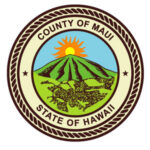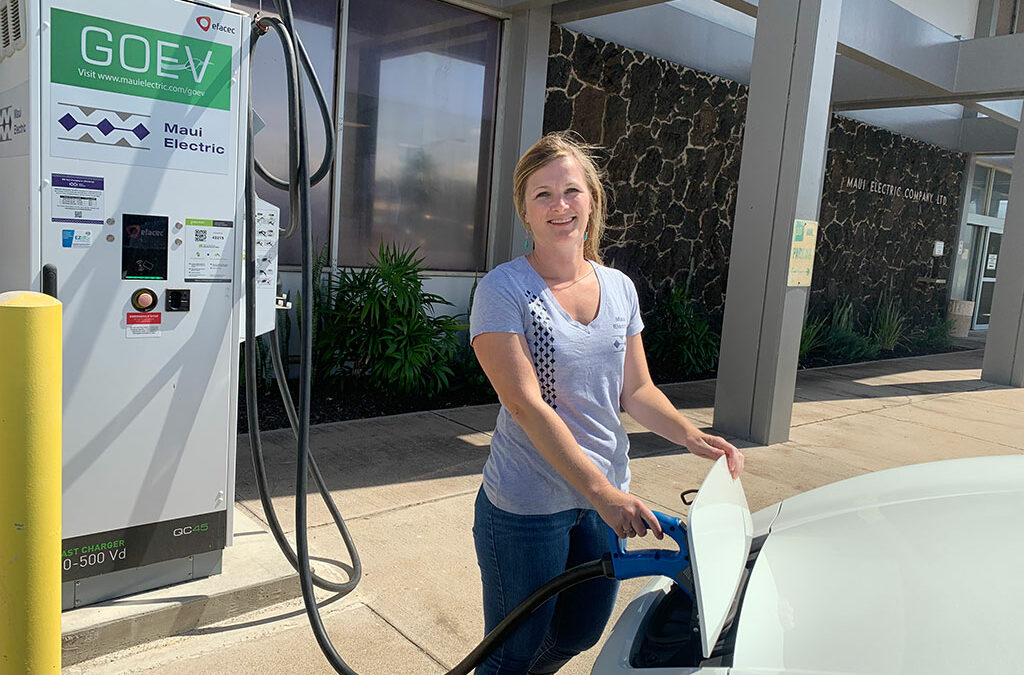
Sep 25, 2019 | Environment, Sustainability
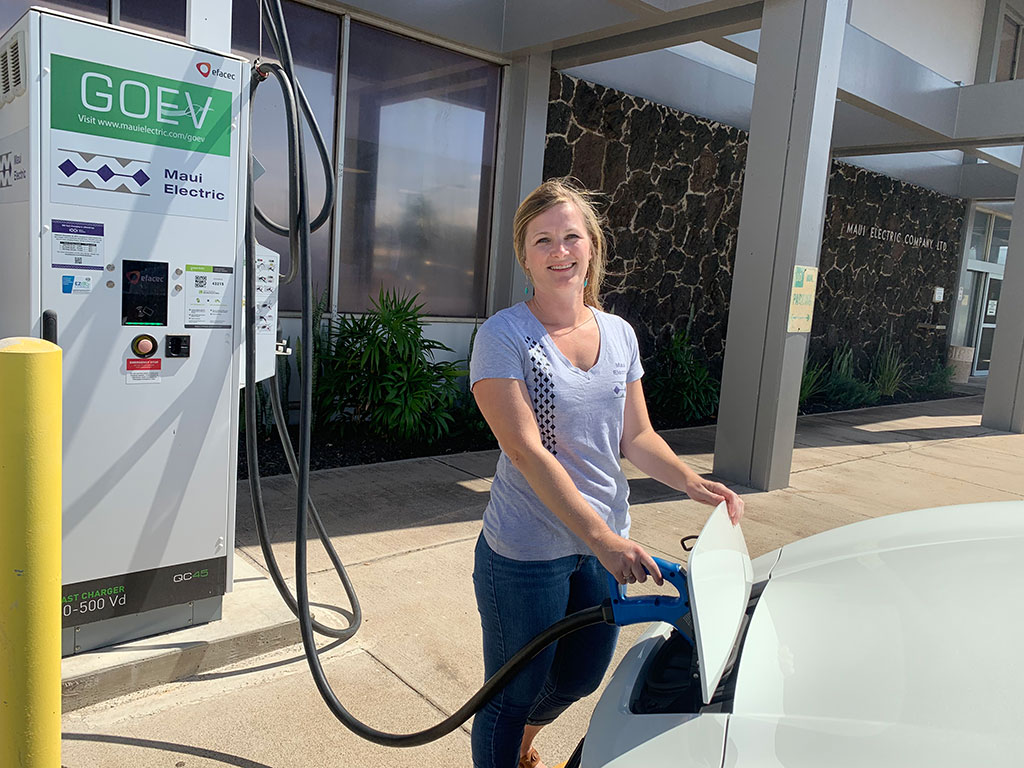
Maui Electric Company has informed the Public Utilities Commission of its intent to move forward with the ownership and operation of four electric vehicle (EV) fast-charging sites in the existing EVohana network on Maui. The EVohana sites, temporarily owned and operated by Maui Economic Development Board (MEDB), were initially established as part of the JUMPSmartMaui demonstration project, a cooperative venture between Japan, the State of Hawaii, County of Maui, MEDB, Hitachi and Maui Electric. Operating from 2011 to 2017, it demonstrated smart-grid technologies that could enable the efficient use of renewable energy on an island grid.
“MEDB, as a nonprofit organization, took on temporary ownership and operation of the EV charging infrastructure in an effort to keep the network in place,” said Leslie Wilkins, MEDB President & CEO. “We appreciate Maui Electric for stepping up to ensure our island continues to have access to reliable public fast-charging options for EV drivers. Without Maui Electric taking on some of these sites, the entire EVohana charging network would have been retired earlier this year.”
At the conclusion of the JUMPSmartMaui project, ownership of the charging assets were transferred to MEDB until a permanent owner and operator of the sites could be confirmed. MEDB partnered with Hitachi to create a new, temporary program called EVohana, which ended March 31, 2019.
Covering the Central, South, West and Upcountry Maui areas, the sites, allowing more EV types to charge, are located at the Queen Ka’ahumanu Center, Pi’ilani Village Shopping Center, Lahaina Aquatic Center, and Pukalani Terrace. EV drivers will be able to “pay-as-you-go” with multiple ways to initiate charging sessions, from smartphone apps to credit cards. Rates will be as low as 0.28 cents per kilowatt-hour between 9am and 5pm.
“As we work to add more clean energy to power our islands, EVs can play an important role in further reducing our dependency on fossil fuel and protecting our environment,” said Sharon Suzuki, president of Maui Electric. “We are pleased to add our support by taking on the four sites with lower charging rates that encourage plugging in when we have a lot of solar energy on the electrical system.”
This October, Maui Electric, along with Hawaiian Electric and Hawaii Electric Light, will be proposing a comprehensive electrification-of-transportation workplan that further details the companies’ expanded role in the deployment of EV charging infrastructure for Maui County, Oahu and Hawaii Island.
Sharon Suzuki, Maui Electric, President
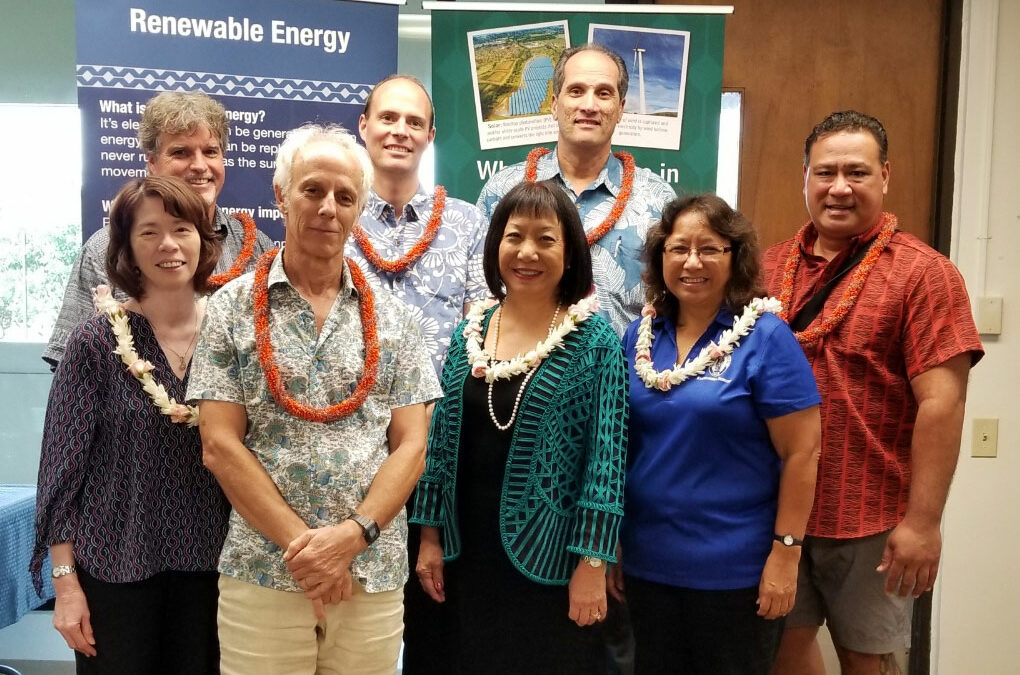
Aug 7, 2019 | Environment, Events, Sustainability
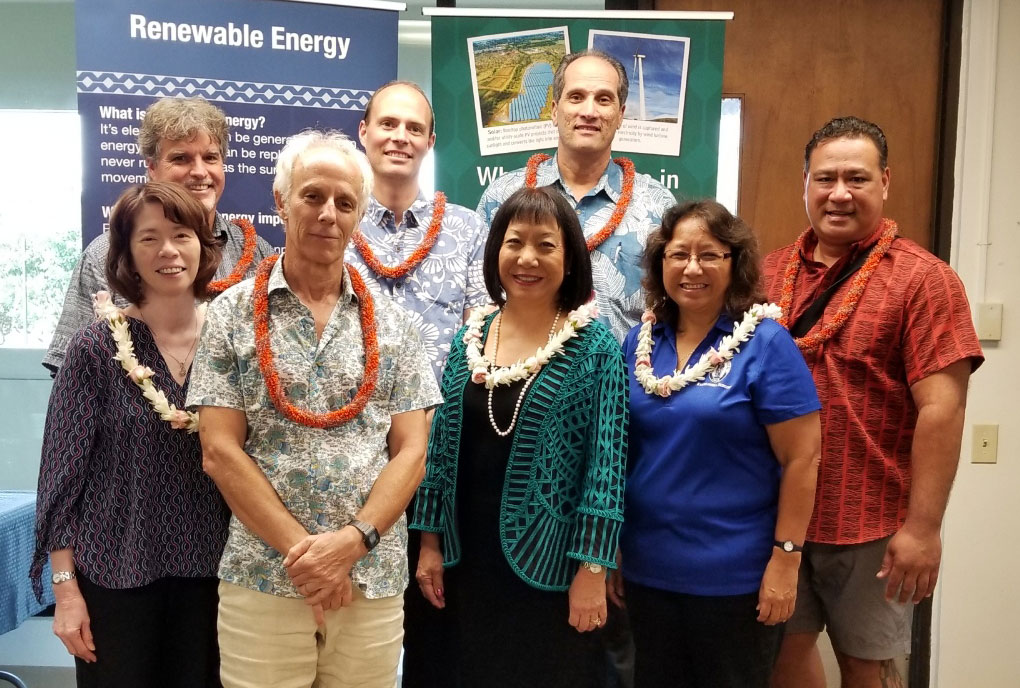
The first community forum on 100% Renewable Energy: What Will Maui Look Like? took place recently at the Cameron Center in Kahului. Coming on the heels of the 2019 Hawaii Energy Conference and Exhibition, the standing-room only event, presented by Maui Electric Company (MECO) in partnership with Maui Tomorrow and the Sierra Club, outlined the challenges and some solutions for Maui’s renewable future.
“We’ll have different ideas on how to achieve our clean energy future,” said Sharon Suzuki, president of Maui County and Hawai’i Island Utilities. “Achieving the goal of 100 percent renewables by 2045 requires all of us working together. As Maui Electric starts to put more bids out to procure more renewable energy projects for the island, it will require informed energy developers, available land resources, and ongoing dialogue with our communities, regulators and government leaders.”
Moderator Mahina Martin, Manager, Government and Community Relations at Maui Electric, led the forum featuring the following panelists: Kumu Kapono’ai Molitau, Kumu Hula; Albert Perez, Executive Director, Maui Tomorrow Foundation; Chris Reynolds, System Operations Director, Maui Electric Company; Alex De Roode, Energy Commissioner, County of Maui; Dana Sato, Asset Management Director, Kamehameha Schools; and Rob Weltman, Chairperson, Sierra Club Maui Group.
Weltman said, “Maui can and must be powered by carbon-neutral, local, environmentally friendly technologies, including solar and wind. Contributing to sea level rise and extreme weather events through continued dependence on fossil fuels is not an option for our vulnerable island community.”
Perez described a community solar program. “The project provides solar energy to residential and commercial customers without access to privately-owned rooftop solar, including many renters and apartment dwellers.”
De Roode, on electrification of transportation, said, “Ground transportation today accounts for one quarter of Hawaii’s fossil fuels consumption and over one quarter of greenhouse gas emissions. MECO is focused on initiatives to advance the switch from gasoline to electric vehicles, helping to reduce Hawaii’s dependence on imported oil.”
Molitau and Sato agreed, “It is our malama ‘aina to care for the land− physically and spiritually. Together, we must understand the need to preserve and protect our natural resources for our future generations.”
As of 2019, private rooftop and utility-scale solar, biofuel and wind resources boosted the amount of renewable energy used to generate electricity in Maui County to 38 percent. We’ve exceeded the state’s goal of 30 percent renewables by 2020, lowered greenhouse gas emissions from our generators, and reduced the amount of oil we used.
Sharon Suzuki, President of Maui County and Hawai’i Island Utilities
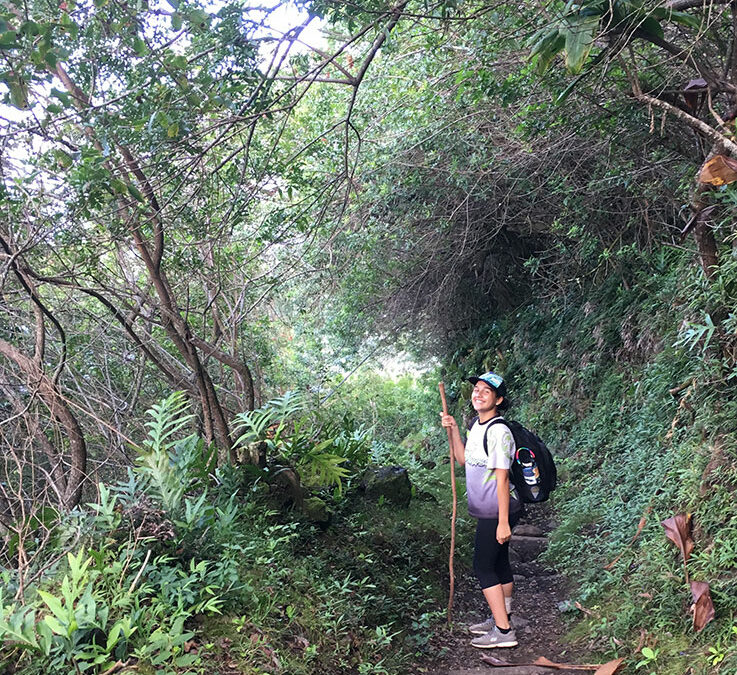
Jun 12, 2019 | Environment, Sustainability

Molokai High School senior, Cameryn Rae Kahalewai won numerous awards, including first place overall in the senior division at the 60th Maui County Regional Science & Engineering Fair held at the Maui Beach Hotel. Kahalewai’s project, “The Effect of Soil Type, Salt, and Feral Animal Fencing on the Plant Distribution and Abundance on Kalaupapa Peninsula, Molokai”, also won her an invitation to represent Maui District in the Intel International Science & Engineering Fair in Phoenix, Arizona in May.
“My project examined the effect of feral animals, soil type, and salt on the distribution of coastal vegetation,” Kahalewai explained. “Using quadrat plant surveys and soil conductivity measurements in two 100-hectare (250-acre) areas with and without deer, I found that soil salt levels were similar across all soil types except for sand. Lower readings for sand could be due to the prevailing wind patterns or soil drainage. Without deer, mineral and organic soil had larger percentages of plant cover, while the sand and mixed soil types had higher percentages of native species present. Comparing the impacts of deer on either sides of the fence, both native and non-native plant cover decreased when deer were present. Four key plant species were selected in the grass, forb, or shrub life form categories. All experienced a decrease in average percent plant cover when deer were present. Based on these results, we can conclude that deer are negatively impacting the coastal salt spray vegetation and species richness regardless of soil type. Fencing appears to improve plant cover, especially for native species growing abundantly in the sand.”
Kahalewai found that both invasive plants and free-roaming ungulates (hoofed animals) are causing detrimental impacts to native plant species. “I wanted to show that if ungulate problems are addressed in time, the remaining native coastal vegetation in damaged areas has a better chance to survive,” she said.
Biology teacher Jeannine Rossa said, “I saw Cameryn’s enthusiasm and understanding of the material develop throughout the semester. This is wonderful field-based science. Kahalewai hopes to major in both environmental science and business marketing in the Fall.”
I hope my research can inform both the Kalaupapa land management and the entire community of Hawaii about the effects of coastal salt spray, soil type and feral animals on coastal vegetation and offer plausible solutions.
Cameryn Rae Kahalewai, Molokai High School senior
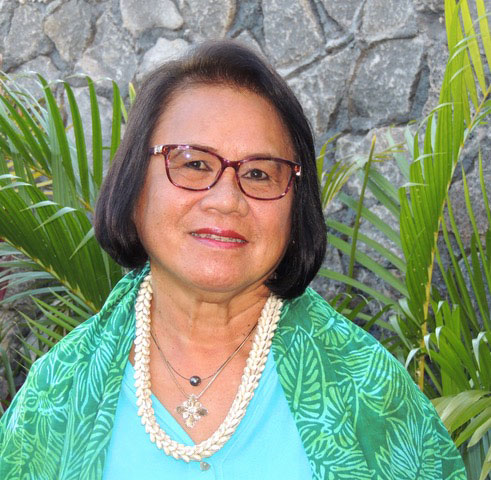
May 15, 2019 | Community, Sustainability

An affordable housing survey focusing on the West Maui community has just begun circulation to help define the extent of the need for affordable workforce housing upon which the West Maui economy depends. The initiative for the survey came from the community itself, led by long-time resident Lori Sablas, who has spent most of her career in the visitor industry. “My Dad worked for Pioneer Mill and purchased our first home in 1969 for $19,380. Our monthly payment was $104 per month; how times have changed!”
Lori knows the value of home ownership and her motivation is to help the West Maui workforce buy a home near their workplace, just as her Dad did. As the former Director of Ka’anapali Beach Hotel’s Project Po’okela program, she developed educational opportunities for staff to learn about Hawaiian culture. She was also instrumental in bringing West Side hoteliers together to support the commuter bus system and subsidizing fares to reduce traffic congestion and make commuting as easy as possible.
Across Maui County, as elsewhere in the state and nationally, affordable housing is a critical issue as supply fails to keep up with demand. Recent studies have shown that it is an issue that represents a major constraint on economic development, and as the Maui County General Plan states, “When adequate or appropriate housing is unattainable to a large portion of the population, it negatively impacts the entire community and decreases overall quality of life.”
Originally shaped by an informal working group of West Side HR directors and employers led by Lori Sablas and further developed by MEDB, the West Maui Workforce Housing Survey is a first step to defining the need through data provided by residents. The exercise will better inform our local community, our policymakers, and real estate development companies about the demand for affordable housing. The survey is entirely anonymous and can be accessed online at www.medb.org/wmsurvey.
In seeking resident input, Lori Sablas notes, “I felt strongly that we need to ask our workforce about this issue and address it from the bottom-up, as opposed to top-down. It’s an initiative than we can deploy in other areas – such as South Maui, if we find the information we collect is useful.”
The West Side Affordable Housing Survey started from a grass-roots level. My sincere hope is that our combined efforts will result in more of our workforce becoming homeowners, just like my Dad did.
Lori Sablas, cultural specialist and community advocate
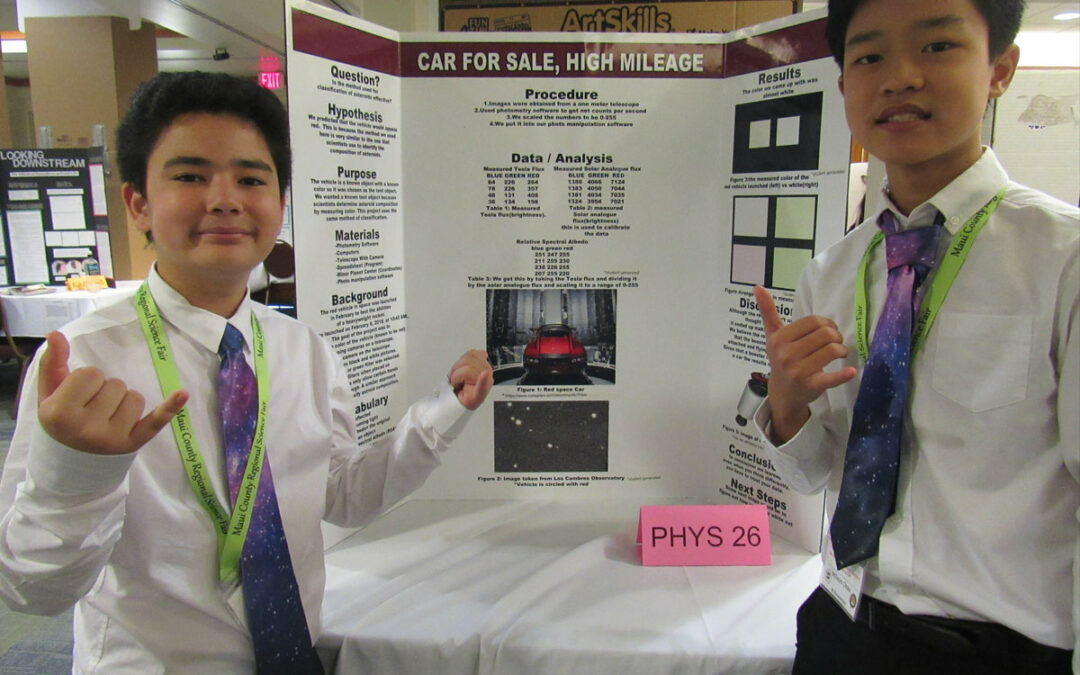
Mar 20, 2019 | Environment, Sustainability
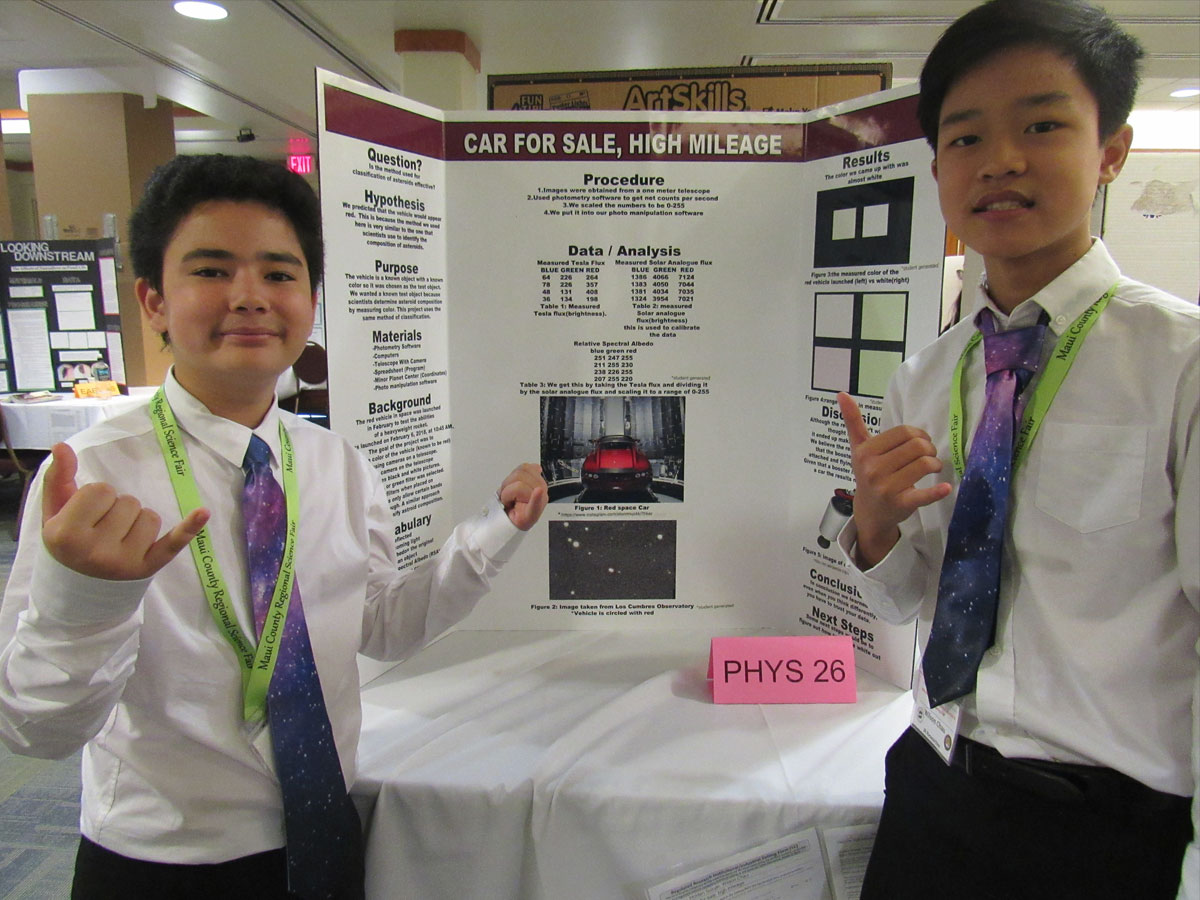
First-place Maui County Regional Science & Engineering Fair Junior Division winners Holden Suzuki and Wilson Chau, Maui Waena Intermediate School STEMworks™ 6th graders, used the scientific method of photometric observations in their award-winning project, “Used Car, High Mileage”. “The purpose of our project was to view the compositions of asteroids through using color, the method commonly used by scientists,” Suzuki and Chau said. “We did this by gathering images of Elon Musk’s cherry-red Tesla convertible that he launched as the payload for the first flight of his new rocket, Falcon Heavy, in February 2018. The upper stage of the Falcon rocket pushed the Tesla car into an elliptical, heliocentric orbit between Earth and Mars.”
Suzuki and Chau explained, “The vehicle, having a known color, was chosen as the test object. We predicted that the vehicle would appear red because we used a method similar to the one scientists use to identify the composition of asteroids. We put data from three different filters into Astrometrica photometry software and got a color that was similar to white. Although the result wasn’t what we thought it would be, it ended up making us think more. We believe the reason it’s white is that the white booster rocket is still attached and flying with the vehicle. Given that the booster is much larger than the car, the results make sense. In conclusion, we learned that, even when we think differently at first, we have to trust our data. Some next steps would be to figure out how to get the white out of our data.”
Holden and Wilson’s mentor, Dr. J.D. Armstrong, Educational Outreach Specialist, University of Hawaii’s Institute for Astronomy, said, “Some people thought there wasn’t really a car up there at all, so we decided to see if we could get some observations to support the claim that it was a car. The first thing that came to mind was to measure the color. This was fun and interesting science. Besides, it might be the real motivation for many of the greatest discoveries in science!”
We are extremely excited to represent Maui District in the Hawaii State Science & Engineering Fair on Oahu, set for April 8-10.
Holden Suzuki and Wilson Chau, Maui Waena 6th graders
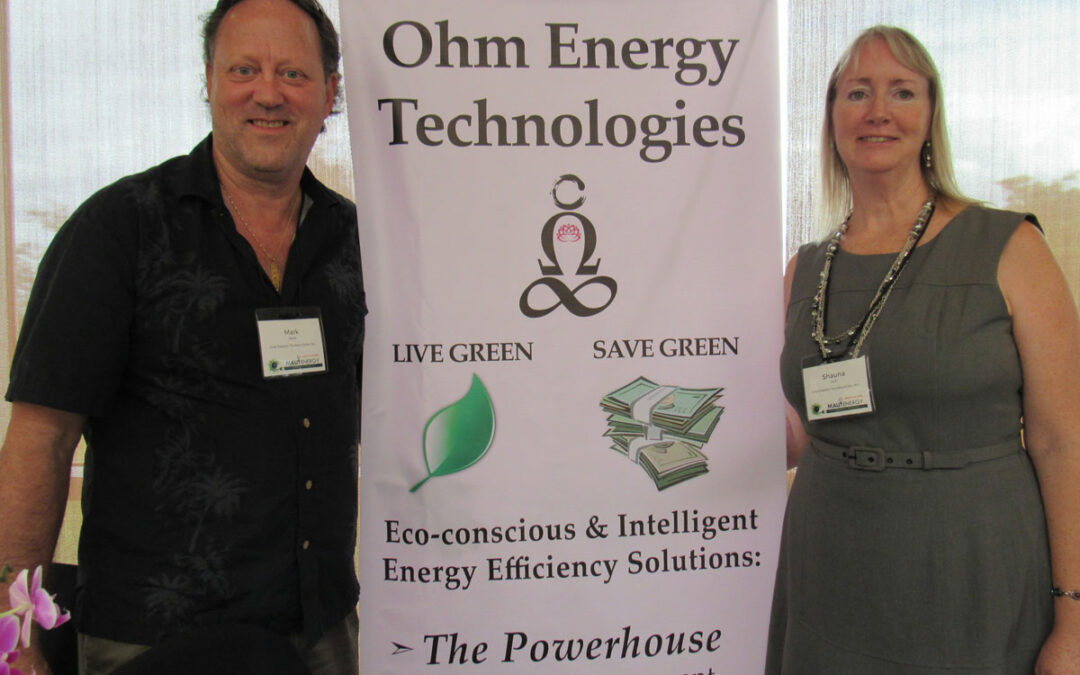
May 23, 2018 | Environment, Sustainability
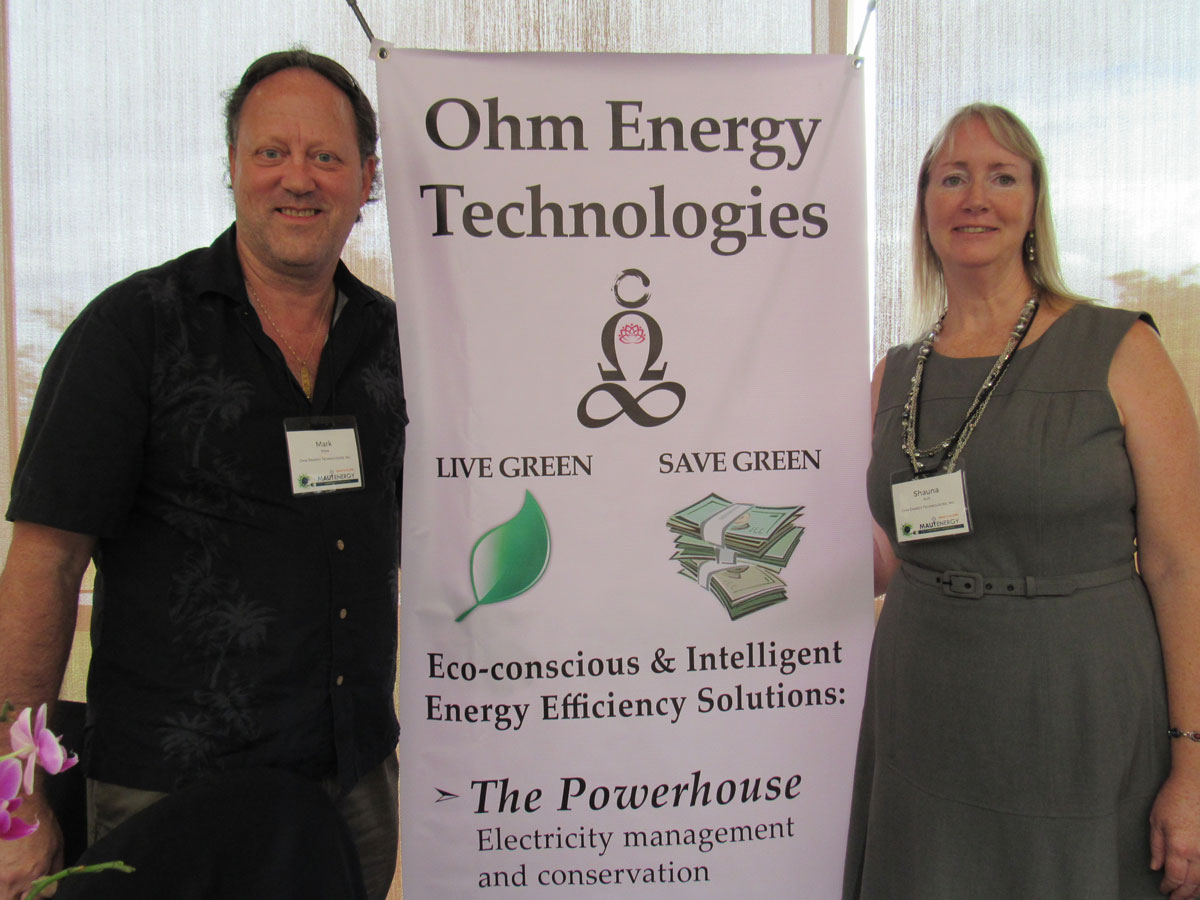
Mark Ware and Shauna Ault of Ohm Energy Technologies, Inc., exhibitors at the 2018 Maui Energy Conference, provide the technical acumen and business management for their family-run company. “Maui called us several years ago, prompting us to create a business that would serve the Hawaii community,” said Shauna Ault. “In 2016, Ohm Energy Technologies relocated from Idaho to Hawaii, to further serve a market experiencing high electricity costs. We are making significant impacts in reducing the consumption of electricity, thus reducing the amount of petroleum fuels burned, as well as saving our customers a significant amount of money on their electricity costs. Hawaii has an aggressive energy efficiency promotion policy, with targets of 100 percent renewable sources of generation by the year 2045. Currently, however, Hawaii still generates approximately 60 percent of its electricity by burning petroleum-based fuels.”
Ohm was established in 2014 to facilitate sales and installation of energy efficiency equipment in a variety of markets. Their primary product, The Powerhouse, was developed by an electrician as a prototype in 2002. It was so successful that it was quickly scaled up to small commercial application. Demand from larger facilities followed. Currently designed for commercial and industrial installations, The Powerhouse has reduced electricity bills by 10, 20, and even 30+ percent, depending on existing efficiency and types of equipment.
“In 2017, Ohm collaborated with manufacturers in California and Maine to develop the next generation of Powerhouse technology: a variable-capacitance system that dynamically adjusts to electricity demand, and a digital internet-accessible monitoring system for rapid access to data and control,” Ault explained. “These systems are now installed in an expanded market on Oahu and Maui, maximizing kilowatt reductions while continuing to provide all other benefits of The Powerhouse. Additional technologies we can implement include state-of-the-art LED lighting for commercial and municipal settings, solar LED street lamps, variable-frequency drives, and harmonic distortion control equipment. With this portfolio of energy efficiency solutions, Ohm Energy Technologies is well positioned to solve many of our energy concerns today, and into the future.”
Hawaii has been our strongest market to date; however, The Powerhouse has been installed in over 700 facilities in the U.S. mainland and Canada.
Shauna Ault, Ohm Energy Technologies, Inc.
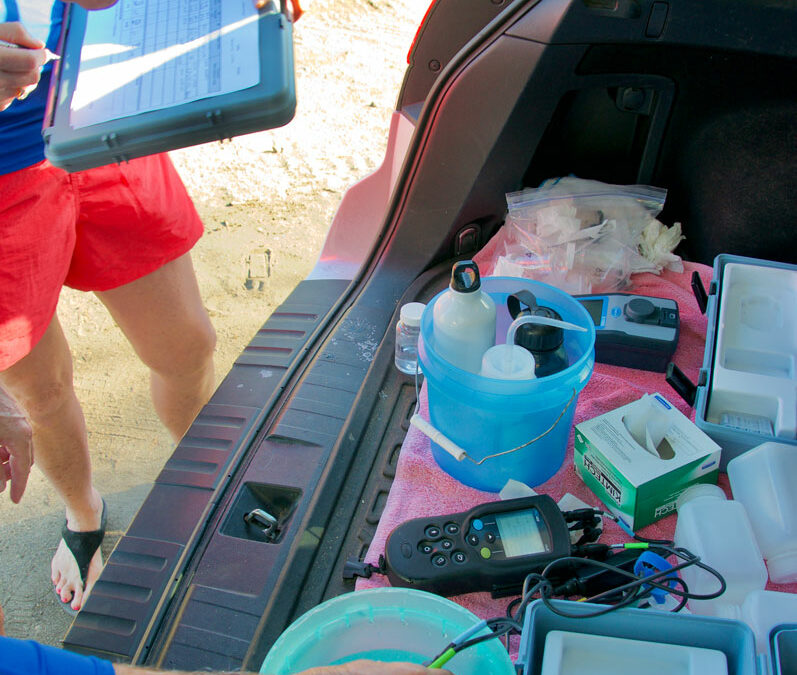
Feb 21, 2018 | Environment, Sustainability

A volunteer-based water quality testing program known as Hui O Ka Wai Ola, Association of the Living Waters, recently began expanding its testing from West Maui to South Maui shoreline locations. The project informs residents about how clean the water is at their favorite beaches. It was made possible through a partnership with the Hawaii Department of Health (DOH), the Maui Nui Marine Resource Council (MNMRC), The Nature Conservancy, West Maui Ridge to Reef Initiative, and the University of Hawaii Maui College.
“Hui O Ka Wai Ola is the first community-based water quality monitoring program in the state,” said Dr. Kim Falinski, Marine Science Advisor at The Nature Conservancy. “It periodically measures turbidity, a measure of water clarity, and nutrients in near-shore ocean water. Robin Newbold, co-founder and chair of MNMRC noted, “Our goal is to support the DOH and Maui County efforts to improve coastal water quality so that coral reefs and native fish populations thrive, and our residents and visitors are safe. We want to help identify problem areas, so remedial action may be taken to address the pollution as quickly as possible.”
Sofia de la Sota, South Maui Regional Coordinator and team leader, said, “A citizen science program like ours would not be possible without an amazing team of volunteers. More than 20 volunteers have completed intensive training and are ready to start water quality testing.” The team will test several factors: turbidity, salinity, dissolved oxygen, pH, temperature, and others. The test for nutrients, such as nitrogen and phosphorous compounds, can indicate pollution from wastewater run-off from agriculture, landscaping, and golf courses. “Too many nutrients in the water can cause an increase in invasive algae, which is damaging to coral reefs,” de la Sota said. “The resulting data will be used to supplement DOH water quality monitoring on Maui and can be viewed at the Hui o Ka Wai Ola website.” To learn more about Hui O Ka Wai Ola, to donate or to volunteer, visit www.huiokawaiola.com.
During every collection period, the volunteers will also collect samples that will be frozen and shipped to the School of Ocean and Earth Science and Technology Laboratory on Oahu for nutrient analysis.
Sofia de la Sota, South Maui Regional Coordinator

Jan 10, 2018 | Community, Sustainability

M’Chelle Aguinaldo, a senior at Lahainaluna High School, was elected and is serving as Secretary of the Hawai’i Chapter of Future Farmers of America (FFA) for 2017-2018. A student-led national organization, FFA is committed to fostering projects that increase awareness of the global importance of agriculture. FFA’s initiative complements Maui Economic Development Board’s (MEDB) vision of achieving a diversified Maui County economy, including agri-tech. Both MEDB and FFA encourage wise management of economic, environmental and human resources in the community, and promote teamwork, citizenship, and volunteerism. They teach that agriculture is more than planting and harvesting—it’s a science, it’s a business, and it’s an art.
“The Lahainaluna High School Agriculture Program’s mission is to help our community grow the next generation of young farmers,” Aguinaldo said. “As this year’s FFA State Secretary, I travel to state and national FFA meetings and assist in work-related activities at Lahainaluna. I also support Maui’s school garden programs with plant donations and other volunteer work.”
Aguinaldo continued, “At Lahainaluna we see a thriving and sustainable Hawaii. We maintain a pono lifestyle by having aloha for all, and by respecting the culture. We need the next generations of farmers. We also need to help drive Hawaii in the direction of becoming sustainable and help keep produce here. We’re working for a better future for Hawaii’s youth and economy.”
Lahainaluna Ag offers a variety of classes. Their facility consists of two classrooms, a shop, a greenhouse, multiple small and large fields, a plant nursery, and a Hawaiian garden. “The curriculum places a high emphasis on giving students as many visual and hands-on learning experiences as possible,” said Aguinaldo “We sell our produce to the community and at local farmers markets, to our school staff, to other Lahaina schools, and to local businesses. We also give back to our community by providing donations of produce and plants to school gardens, homeless shelters, senior housing complexes, and the Maui Food Bank.”
FFA students develop an appreciation for a farming career and other agriculture-related professions such as biologists, chemists, veterinarians, engineers and entrepreneurs.
M’Chelle Aguinaldo, Lahainaluna High School, 12th grade
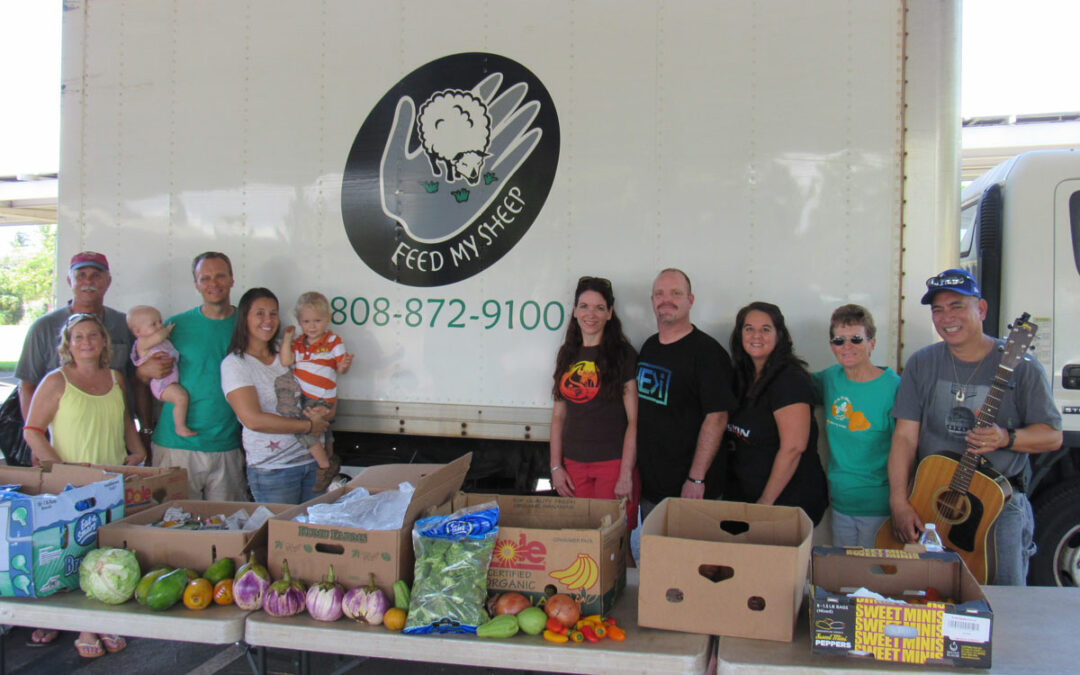
Dec 20, 2017 | Community, Sustainability
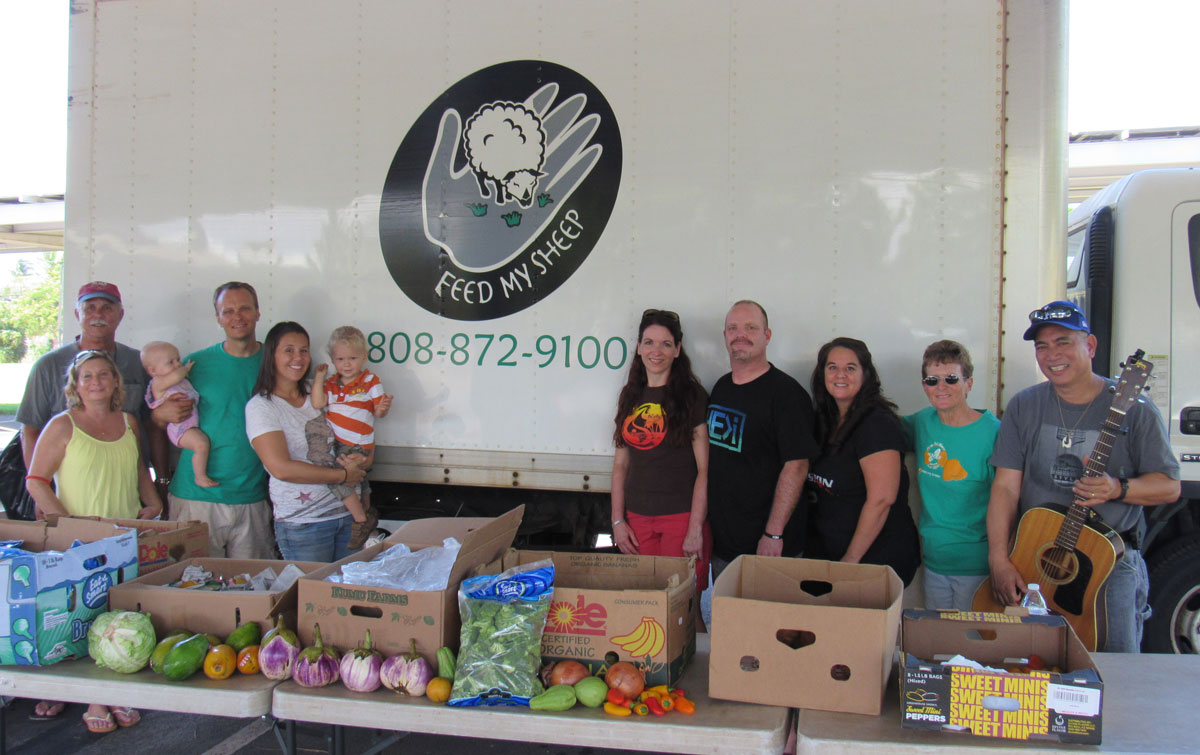
Maui Economic Development Board applauds the community service of Feed My Sheep (FMS). Serving with integrity and sincerity, this nonprofit makes an immediate impact on the lives of the less fortunate. Bringing positive hope, the many FMS volunteers lift the morale of low-income workers and the unemployed while helping them through rough economic times. “In an effort to make Maui hunger-free, FMS provides about 69,000 half-pound meals a month throughout the island,” said FMS Founder and CEO, Joyce Kawakami. “In the last year we have given food to 3,200 people including working but poor families, seniors on fixed incomes, and homeless men and women. A few moments of emotional support are offered to each person who comes, besides food for their week. We feel blessed to serve so many.”
A unique mobile food distribution program, FMS takes deliveries to designated neighborhoods of need each week. Bags of food are distributed to the needy in five different locations. “Anyone who needs food is welcome to come to one of our many mobile food distributions,” said Operations Director Scott Hopkins. “Our volunteers make FMS such a welcoming place. Plus, many local farmers offer participants a focus on healthier food choices.” For example, Kumu Farms provides FMS with healthy options for both their free distributions and their discounted produce market. They have been a consistent source of nutritious items such as kale, papaya, chard, bananas, arugula, salad greens, beans and fennel.
FMS staff surveyed over 100 people to find out how fresh produce, fruit and vegetables have benefited the participants. “Ninety-six people said that the food they received from FMS improved their health in ways that doctors confirmed,” Hopkins noted. “We documented reduced blood pressure, better heart health, improved mental clarity and increased strength. Through FMS I have seen many people go from their lowest point to a new beginning. That’s what makes it all worthwhile!” FMS is always seeking volunteers for distribution locations in Hana, Lahaina, Wailuku, Kahului, and Kihei. To inquire call (808) 872- 9100.
Through Feed My Sheep I have seen many people go from their lowest point to a new beginning. That’s what makes it all worthwhile!
Scott Hopkins, Feed My Sheep Operations Director
















